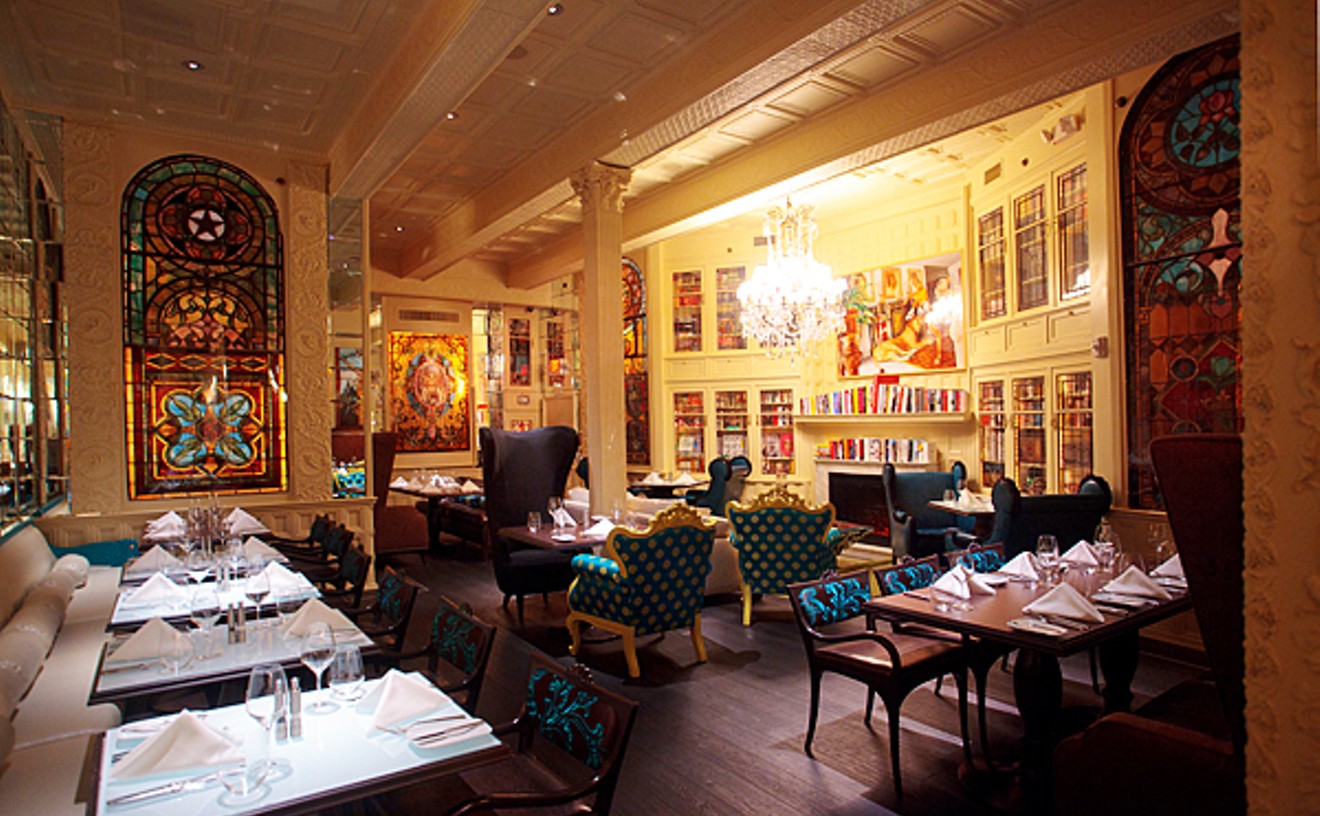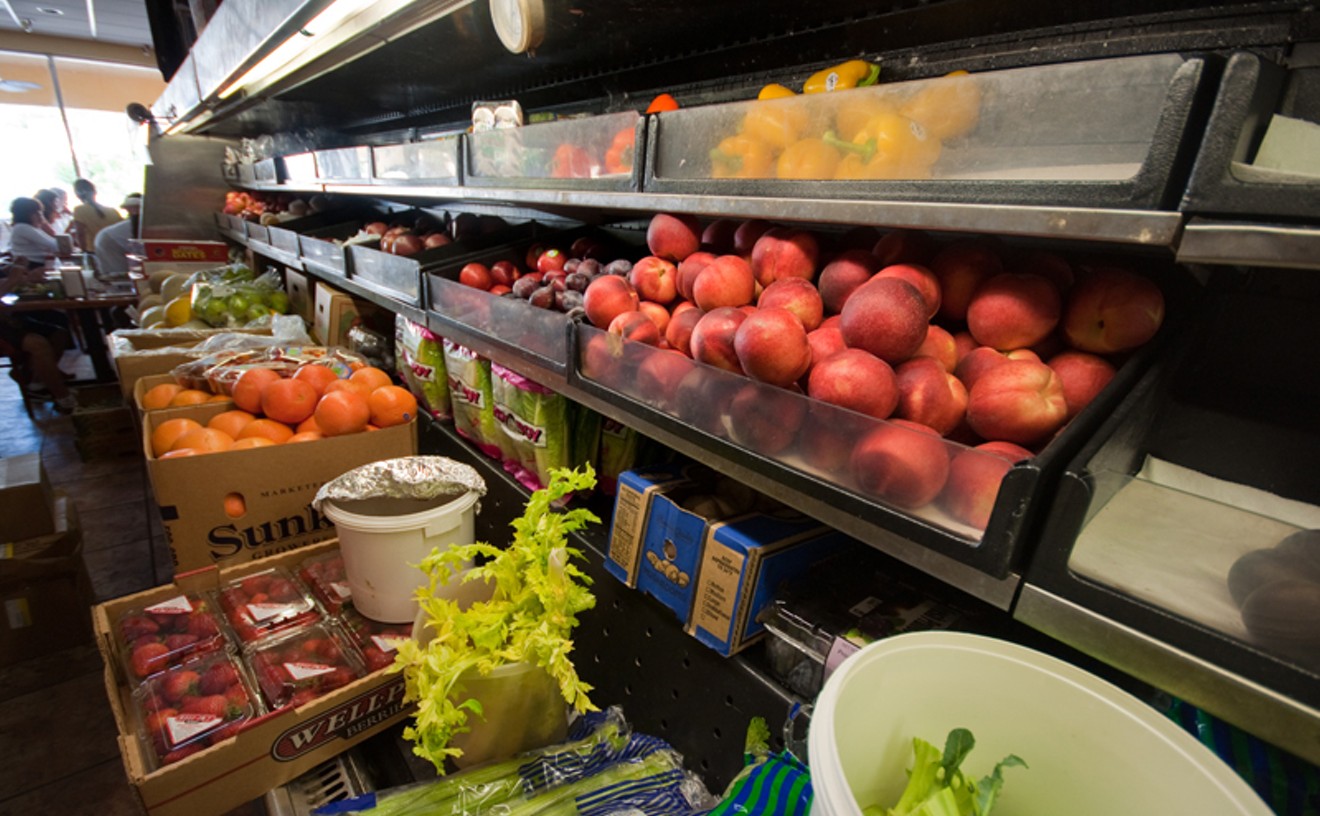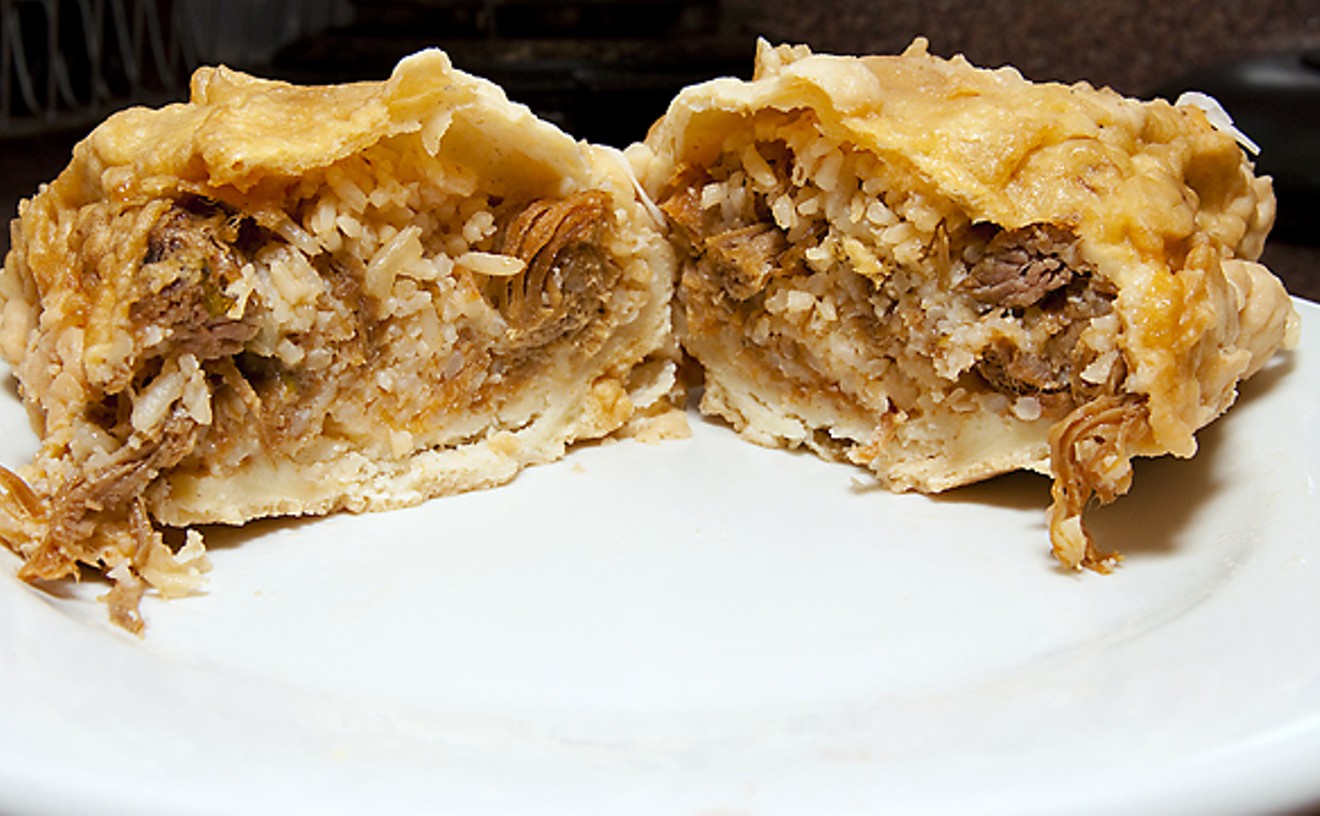Best Late-Night Dining
The Alibi

Natalia Molina
Does a Philly cheesesteak sandwich — thinly sliced rib eye, grilled onions, and Cheez Whiz on an Amoroso roll imported from Philadelphia — taste better at 3 in the morning than at any other time? No. It tastes better at 3 in the morning because you are eating it at the Alibi, a food concession within funky SoBe hangout bar Lost Weekend. It tastes better because co-owner Bill Sisca is from Philadelphia and partner John Ross is a CIA-trained chef. Two more reasons: It costs just $8.95, and you are eating it with a side of the freshly made crinkle-cut fries ($4.95) with an available side ($1 extra) such as chipotle or truffle oil or more of that Cheez Whiz (can you really ever have too much?). Plus you are getting a taste of your mate's shrimp poboy sandwich. It tastes better at 3 in the morning because you are keeping the night alive by ordering drinks from the bar while you goof around at the pool table and you are already thinking of capping off your late-night Dagwood-inspired binge with one of John's girlfriend Kristie's now-famous strawberry shortcake cupcakes — another house specialty — and of course you'll buy a second cupcake because (A) they're so good and (B) it's one for $3 but two for $5,and you'll wonder if it wouldn't make sense if you took a bacon-chicken Philly or an all-beef hot dog to go (only five bucks!), because at that point, it'll be around 5 in the morning (closing time at the Alibi), and breakfast will be, let's face it, just around the corner.
- 218 Española Way, Miami Beach, 33139 Map
- 305-674-3448
Best Wine Selection in a Restaurant
The Forge

billwisserphoto.com
The Forge for decades has had one of the most impressive wine cellars in town. However, with the relaunch of the "new" Forge a few months ago, enophiles on a budget have a reason to celebrate. Along with its revamped menu and décor, the Forge has introduced an enomatic wine system that allows patrons to sample more than 80 wines for a fraction of the cost of buying the whole bottle. The eight stainless-steel-and-glass wine stations are divided up by varietal and taste (think Red Powerful). Patrons simply insert a black Forge card into the machine and choose which size pour they want (from one to five ounces). From there, this upscale vending machine dispenses the wine directly into the glass. Ever wanted to taste a superexpensive wine like Opus One? Well, now you can for $13 for a one-ounce sip. Serious tipplers need not worry, though. There are more than 600 bottles on the main wine list, and owner Shareef Malnik's renowned cellar is still intact. Despite the economy, customers still pay more than $5,000 for bottles such as the 1975 Château Haut-Brion, Premier Grand Cru Classé. Ask for a consult with executive sommelier Gino Santangelo, who has been with the Forge for 35 years. Not only can he suggest the perfect wine pairing with the bone-in 18-ounce filet mignon, but also he leads private tours of the wine cellar. Regardless of whether you are a wine novice or a snob, spending time at the Forge's grape-friendly bar will leave you tipsy and well educated.
- 432 W. 41st St., Miami Beach, 33140 Map
- 305-538-8533
- theforge.com
Best Smoothie
Miami Juice

Aran S Graham
Today a cell phone can no longer be just a phone. It has to be a camera, a stereo system, a minicomputer, and an all-purpose replacement for human contact all in one. Smoothies have suffered a similar demand for multifunction. You can get ones that promise weight loss, muscle gain, better concentration, cures for minor ailments, even boosts to the libido, all while also being packed full of sweeteners and preservatives to make them taste like candy. It's gotten so out of hand that you can walk out of a national chain that promotes itself as healthy with 30 ounces of peanut butter-flavored sludge that adds up to 1,170 calories (that's, like, about two KFC Double Downs). Time to get back to basics, and that's exactly what Miami Juice does best. The charming juice bar, restaurant, and health food store is located in a strip mall on Sunny Isles Beach. The smoothies are made from basic combinations of mostly organic fruits and ice, nothing more, nothing less, and they taste great. Well, yes, you can get a protein smoothie too (which also tastes delicious), but as life keeps getting more complicated, we prefer to keep things simple.
- 18660 Collins Ave., Sunny Isles Beach, 33160 Map
- 305-945-0444
- miamijuice.com
Best Cafe con Leche
Bread n' Pan Cafeteria

Google Street View
They say that when Egyptian shepherds discovered coffee, their goats began to dance. Had it been espresso, there also would have been some serious headbanging, followed by a tango and then a cabbage patch and a crash-and-burn. At Bread n' Pan — a teensy, one-woman joint on a hidden industrial strip of little Haiti — they make the stuff strong. You'd miss this out-of-the way shop were it not for the canary-yellow overhang that simply reads, "Cafeteria." The lone Latina barista makes Starbucks look like an assembly line of factory workers. She takes her time, steaming milk in front of a one-shot espresso machine, and will customize your sweet, creamy (not foamy!) beverage with your preferred sugar-to-espresso ratio. There is no place to sit, so expect to stand. The upside: There is never a crowd, and an eight-ounce café con leche goes for just $1. It would be hard to find a cheaper one — well, west of Egypt anyway.
- 333 NE 69th St., Miami, 33138 Map
- 305-759-4178
Best Salad
Grimpa Steakhouse

Talk about a great value. For only $12.99, lunchtime diners get their fill of addictive cheese bread and can partake in Grimpa's whopping 28-item salad bar, comprising 20 types of salad and eight hot dishes. (The cost for this same meal at dinner rises to $26.50 per person, so tell Mr. or Ms. Tummy to get with the afternoon plan.) Grimpa isn't one of those places that serves canned three-bean stuff or throws together a bowl stuffed with 99 percent iceberg lettuce. This is a choose-it-yourself, all-you-can-eat salad lovers' orgy, with handmade options that change daily. Even vegetarians can get their fill because choices sometimes include waldorf, tabouli, caesar, and lentil salads, along with starches such as white rice, black beans, mashed potatoes, and steamed vegetables. Of course, it's always tempting to wrangle one of the gauchos for a little taste of some cow flesh, but we say ignore what your mama always taught you and fill up on salad instead.
- 901 Brickell Plaza, Miami, 33131 Map
- 305-455-4757
- www.grimpa.com
Best Coffeehouse
Pasion del Cielo

If you ever find yourself half-naked in a Coral Gables condo at 10 p.m., grinding your teeth and picking your scabs, you have a problem. You need caffeine and you need it badly. But there's a bigger problem. Your usual supplier, Starbucks, has already closed for the night. Ditto for Barnes & Noble. Even your supersecret, emergency espresso supply has been consumed. Now, where in hell are you gonna get some high-grade java in this neighborhood at this time of night? Hit Pasión del Cielo. Open from 7 a.m. to 11 p.m. every day of the week, Pasión has beans from almost every Latin American producer: Brazil, Colombia, Costa Rica, Cuba, Guatemala, Honduras, Mexico, Nicaragua, and Peru. And like you, this place is dangerously crazy for coffee. Every single dose is custom-ground, using dedicated grinders for each country's coffee in order to, in the words of the store's corporate pamphlet, "prevent flavor contamination and to electronically dose the exact amount and coarseness level." Plus Pasión's menu offers fixes of almost every kind, including $1.55 espresso shots, $1.75 coladas, and $2.60 large coffees. There's even a ton of soft-core stuff such as peach-strawberry sparkles, chai tea lattés, and mocha-chip frappés. The craziest part, though: Anytime between 11 a.m. and 6 p.m., this coffeehouse delivers hot black stuff directly to the doors of teeth-grinding, scab-picking, condo-dwelling java junkies all over Coral Gables.
- 100 Giralda Ave., Coral Gables, 33134 Map
- 305-448-0007
- pasiondelcielocoffee.com
Best Nicaraguan Restaurant
Pinolandia

George Martinez
This fritanga is not gonna win any interior design awards. It looks like your abuelita's kitchen. But you're not coming here for a fancy sit-down dinner. This is 24-hour Nicaraguan take-out at its most epic. You get it and go. The first indication Pinolandia is way better than the rest: a never-ending, always-growing line of 30-plus Nicaraguan locals and wandering foodies that winds and twists out the door, spilling into the tiny, street-facing parking lot. The second indication: your $8 Styrofoam container packed with three pounds of carne asada, sweet plantains, deep-fried cheese, salad, and gallo pinto. The third indication: a huge selection of second options, including carne desmenusada, stewed beef tongue, whole fried fish, gooey grilled ribs, and rolled tacos stuffed with shredded meat. And remember to hit the little bodega at the back. It has everything from powdered bleach to Nicaragua's national soda, Milca, to bootleg DVDs of boxing legend Alexis Argüello's greatest fights. The essential buys, though, are a 32-ouncer of milky cacao and a hot, fresh batch of deliciously fat Nicaraguan tortillas. So go, loco.
- 119 NW 12th Ave., Miami, 33128 Map
- 305-325-8663
Best Fajita
El Rancho Grande

The simple-minded contend that all fajitas are created equal. Take some tortillas, throw on some hot strips of beef or chicken, a green pepper or two, maybe some guacamole, and — boom — ya got a fajita. What's the difference, right? Anyone silly enough to make that argument hasn't visited any of El Rancho Grande's three Miami locations lately. The difference, poor ignorant soul, is in the ingredients. The tortillas are hot, fresh, and bear no resemblance to the crusty white excuse you'll find at Taco Bell. The garlic-tinged beef is tender and juicy; the strips of pork are succulent and rolled in spices. The peppers and onions crackle and marinate in aromatic juices. Top it all with homemade guacamole, roll it up, and just try to claim that a fajita is a fajita. This, in fact, is a fajita.
- 314 72nd St., Miami Beach, 33139 Map
- 305-864-7404
- www.elranchograndemexicanrestaurant.com
Best Fried Chicken
Magnum Restaurant & Lounge

Few people would suspect that a piano bar blaring live show tunes is the site of the tastiest, crispiest fried chicken in Miami. Such is the case at Magnum Restaurant and Lounge, a local institution known for its kitschy atmosphere and savory dishes. Of course, anyone who dined at Jeffrey's on Lincoln Road in the '90s knows that owner Jeffrey Landsman is a foodie. Although he is long gone from SoBe, another casualty of the chainification of Lincoln Road, his latest spot is also teeming with excellent, simple, well-executed fare. Magnum's home-style menu evokes a different era, with classics such as French onion soup, chicken potpie and, yes, fried chicken. The recipe comes from Landsman's mother, who would prepare the fried chicken for Sunday family outings in Baltimore. It is marinated overnight and then coated in flour, salt, garlic, and secret spices. It is fried at 350 degrees for exactly 17 minutes. The resulting bird boasts a thick, well-seasoned crust and tender, steaming-hot meat. Rounding out all of that crunchy goodness is a heap of velvety mashed potatoes with Southern gravy and seasonal vegetables. Although the dish is not cheap at $21.25, the portion is large enough to feed two, but then you'd be missing out on the other house specialties. Undoubtedly, fried-chicken fanatics will be satisfied here.
- 709 NE 79th St. Causeway, Miami, 33138 Map
- 305-757-3368
- www.facebook.com/magnumlounge
Best Empanadas
Pamela's Delicatessen

Pamela Canales sold empanadas from her home for a dozen years before she opened this namesake delicatessen in 1992. It's actually more of a Chilean market/bakery/café/full-service restaurant than a deli, but call it what you will. We call it our home whenever the craving for an excellent empanada arises. Of the five varieties offered, our favorites are the ones filled, respectively, with a "pino" of chopped beef, lots of onions, black olives, hard-boiled eggs, and raisins, and a strange-sounding but delicious duo of minced razor clams and Parmesan cheese. Dabbing some piquant salsa known as pebre on top makes them that much tastier. Other choices are chicken, cheese, and mixed seafood, each encased and baked in pale, sturdy empanada shells that are twice the size of the daintier, more familiar Argentine types — which makes the $2 to $3.25 price an especially good deal. Order some empanadas to go from the bakery section, or grab an affordable bottle of Chilean wine from one of the market shelves up front, take a seat in the quaint dining room in back, and enjoy an epicurean empanada experience — for breakfast, lunch, or dinner.
- 8469 SW 40th St., Miami, 33155 Map
- 305-225-6365
- pamelasrestaurante.com/





